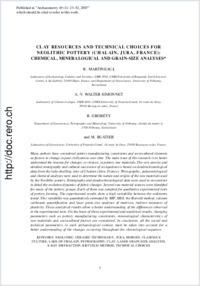Clay resources and technical choices for neolithic pottery (Chalain, Jura, France): chemical, mineralogical and grain-size analyses
DOKPE
- Martineau, R. Laboratory of Archaeology, Cultures and Societies, UMR 5594, CNRS/University of Burgundy, Earth Sciences Centre, Dijon, France - Department of Geosciences, Petrography and Mineralogy, University of Fribourg, Switzerland
- Walter-Simonnet, A.-V. Laboratory of Chrono-écologie, UMR 6565, CNRS/University of Franche-Comté, Besançon, France
- Grobéty, Bernard Department of Geosciences, Petrography and Mineralogy, University of Fribourg, Switzerland
- Buatier, M. Laboratory of Geosciences, University of Franche-Comté, Besançon, France
-
20.02.2007
Published in:
- Archaeometry. - 2007, vol. 49, no. 1, p. 23–52
Neolithic
ceramic technology
Jura
Horgen
Clairvaux culture
Lake of Chalain
petrography
clay
laser grain-size analysis
X-ray diffraction
rietveld method
technical choices
English
Many authors have considered pottery manufacturing constraints and sociocultural elements as factors in change in past civilizations over time. The main issue of this research is to better understand the reasons for changes, or choices, in pottery raw materials. The very precise and detailed stratigraphy and cultural succession of occupations is based on dendrochronological data from the lake-dwelling sites of Chalain (Jura, France). Petrographic, palaeontological and chemical analyses were used to determine the nature and origins of the raw materials used by the Neolithic potters. Stratigraphy and dendrochronological data were used to reconstruct in detail the evolution dynamics of fabric changes. Several raw material sources were identified for many of the pottery groups. Each of them was sampled for qualitative experimental tests of pottery forming. The experimental results show a high variability between the sediments tested. This variability was quantitatively estimated by XRF, XRD, the Rietveld method, calcium carbonate quantification and laser grain-size analyses of matrices, indirect measures of plasticity. These analytical results allow a better understanding of the differences observed in the experimental tests. On the basis of these experimental and analytical results, changing parameters such as pottery manufacturing constraints, mineralogical characteristics of raw materials and sociocultural factors are considered. In conclusion, all the social and technical parameters, in each archaeological context, must be taken into account for a better understanding of the changes occurring throughout the chronological sequence.
- Faculty
- Faculté des sciences et de médecine
- Department
- Département de Géosciences
- Language
-
- English
- Classification
- Archeology
- License
- License undefined
- Identifiers
-
- RERO DOC 6655
- DOI 10.1111/j.1475-4754.2007.00286.x
- Persistent URL
- https://folia.unifr.ch/unifr/documents/300213
Statistics
Document views: 180
File downloads:
- grobety_crt.pdf: 256
